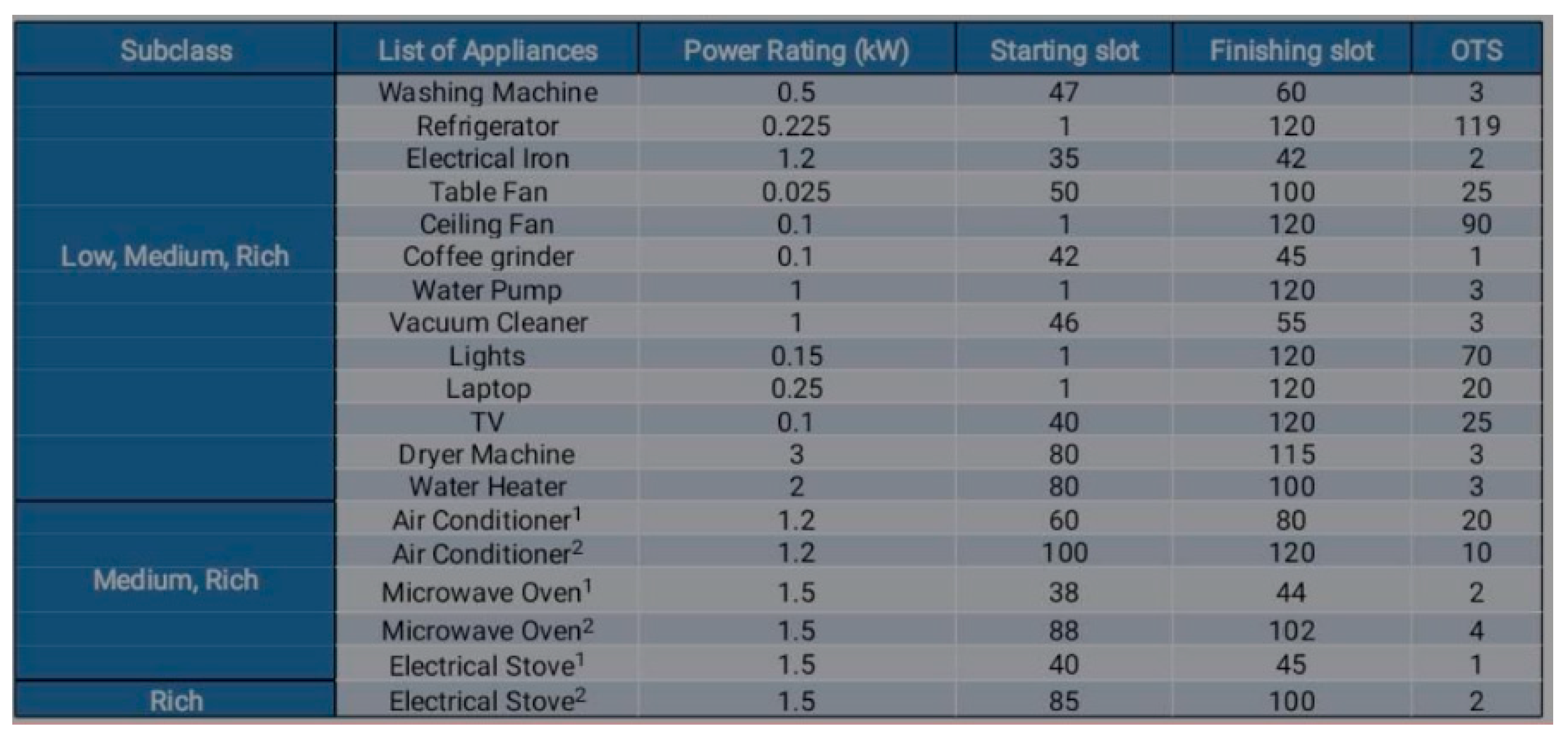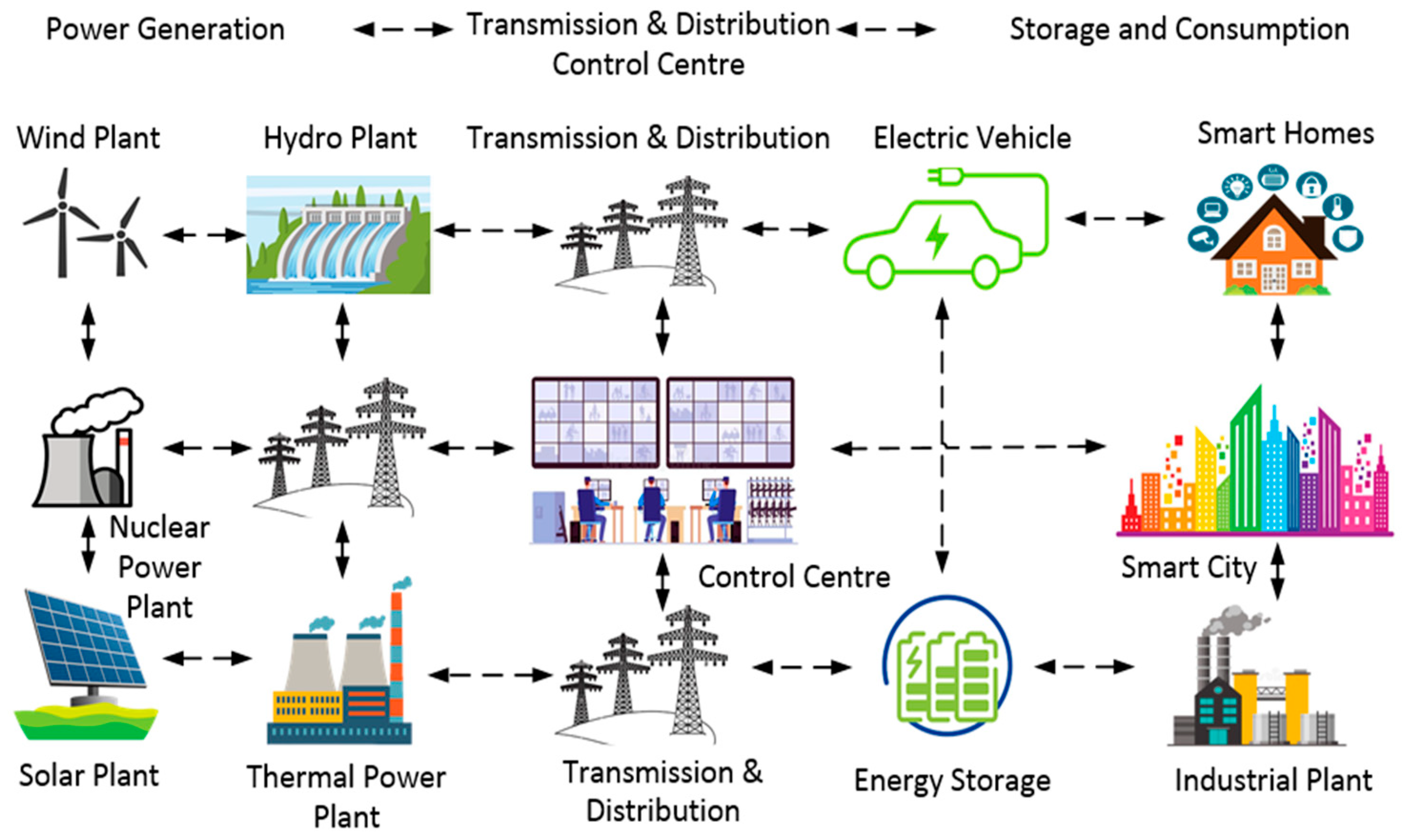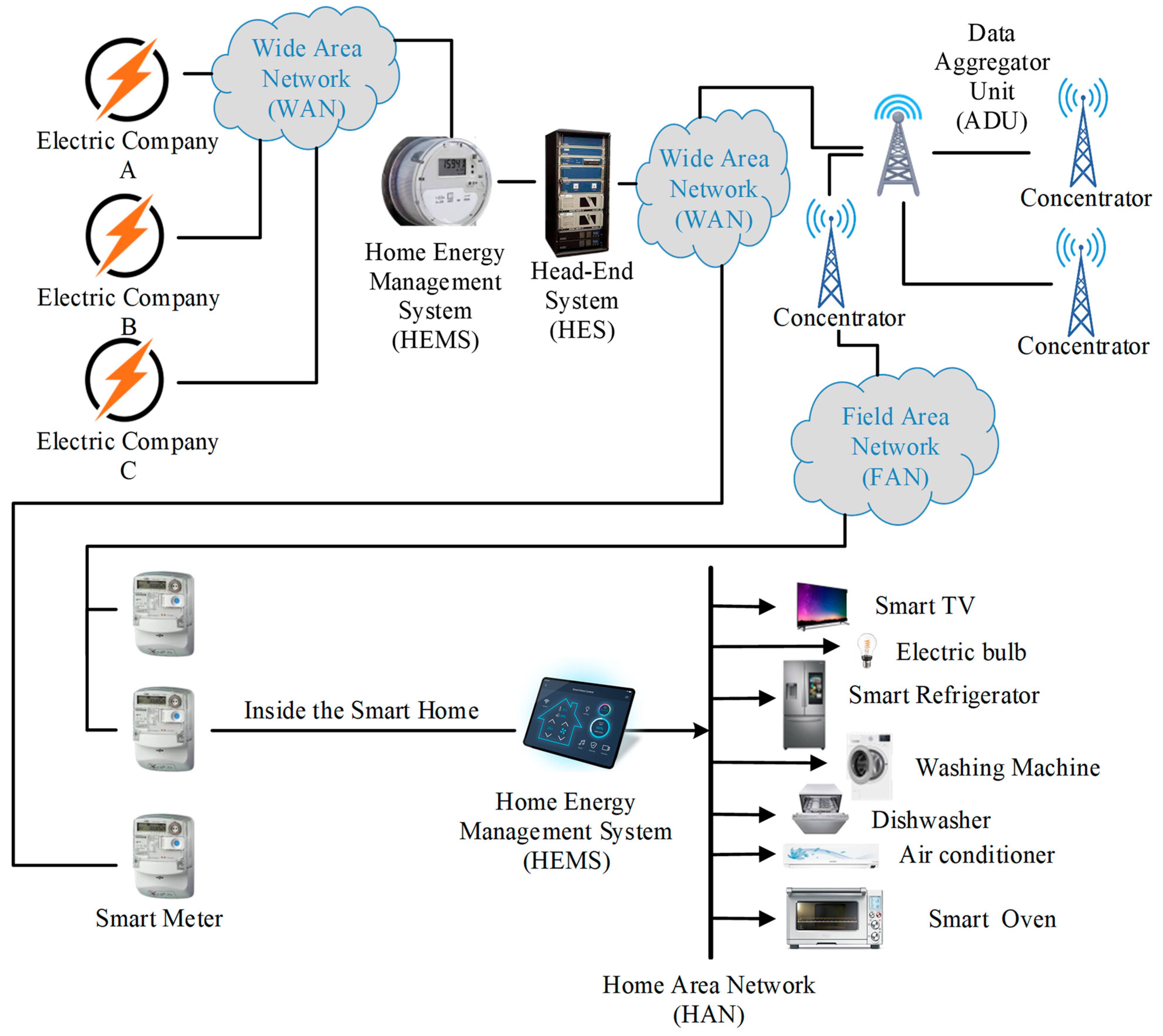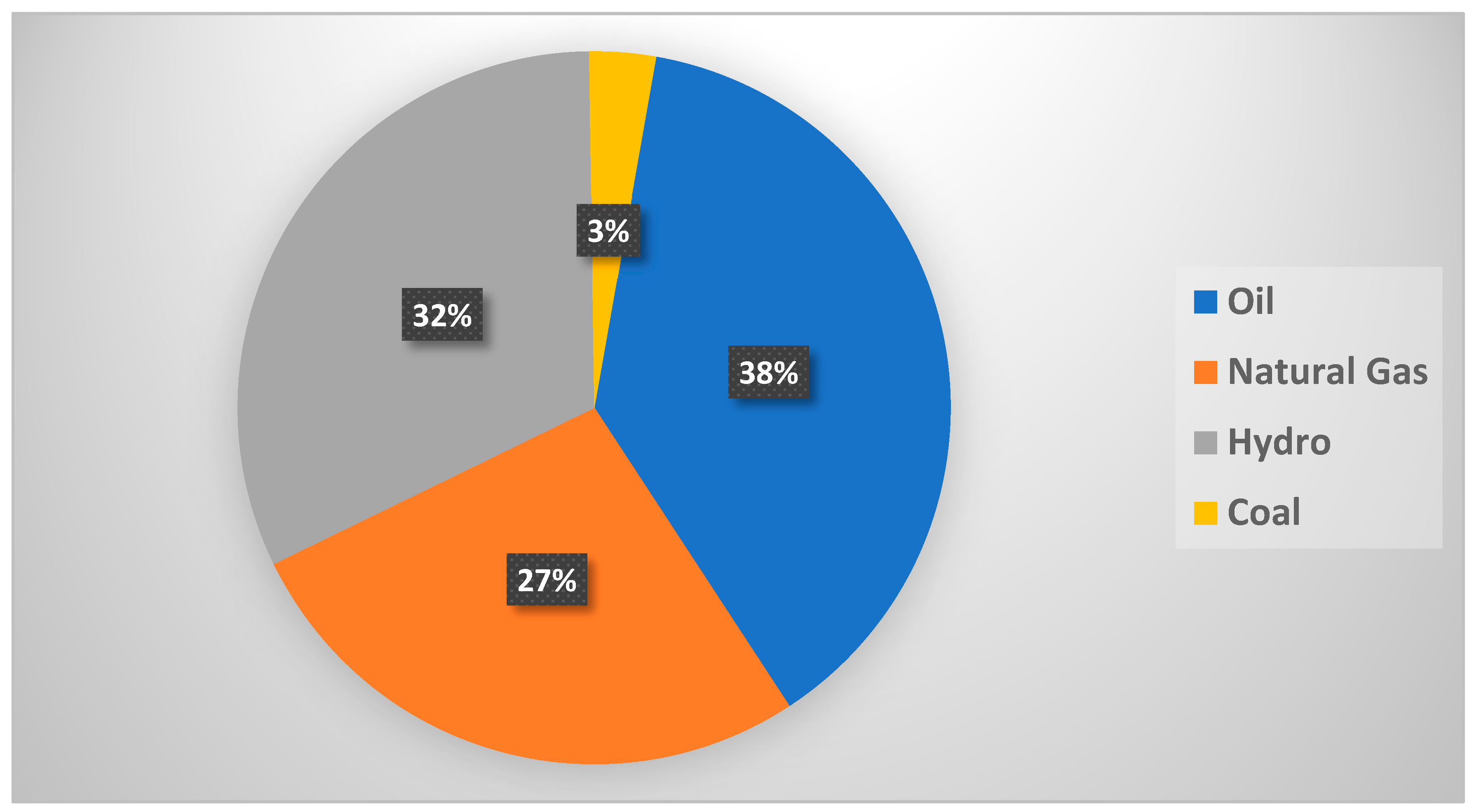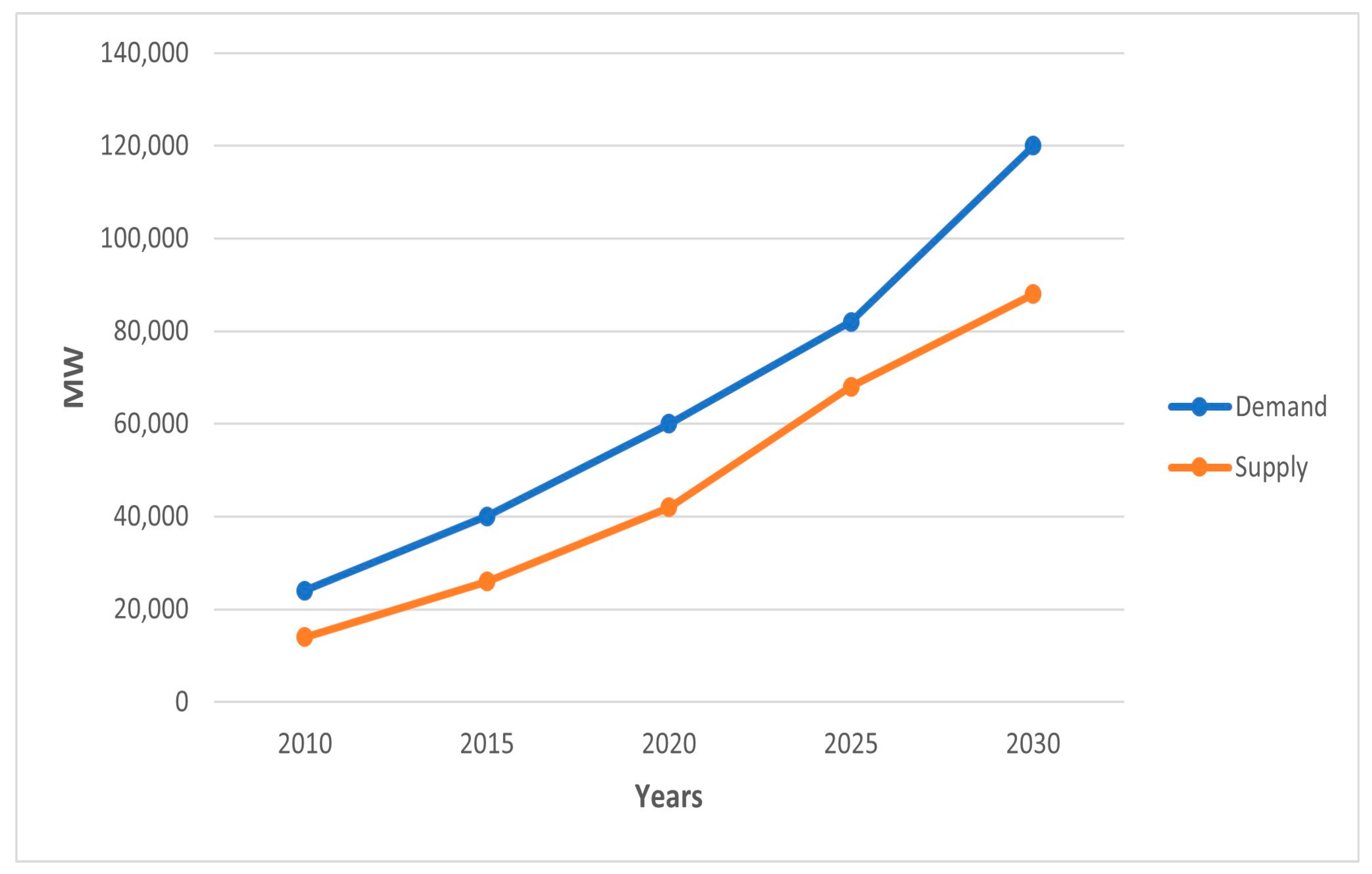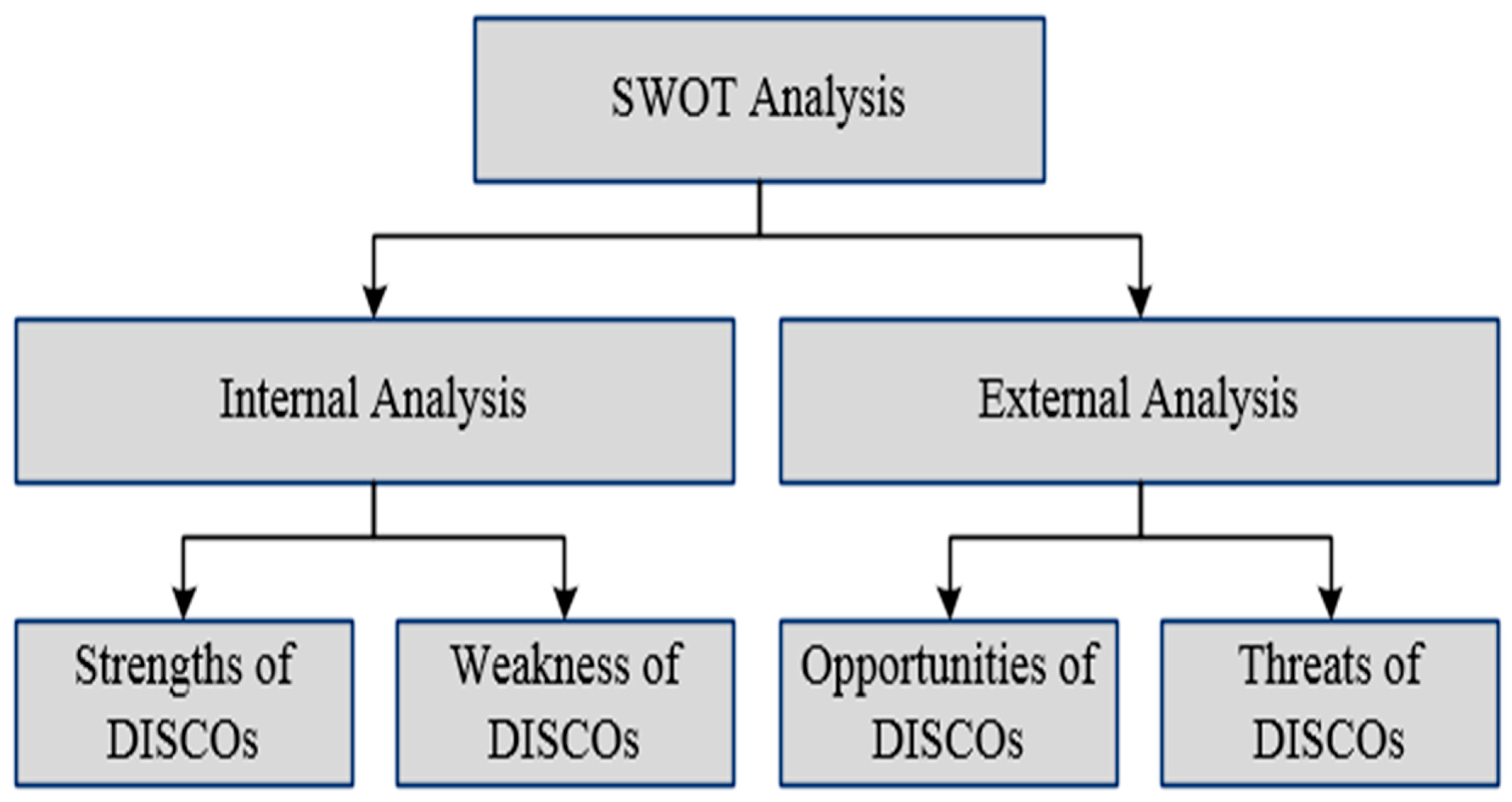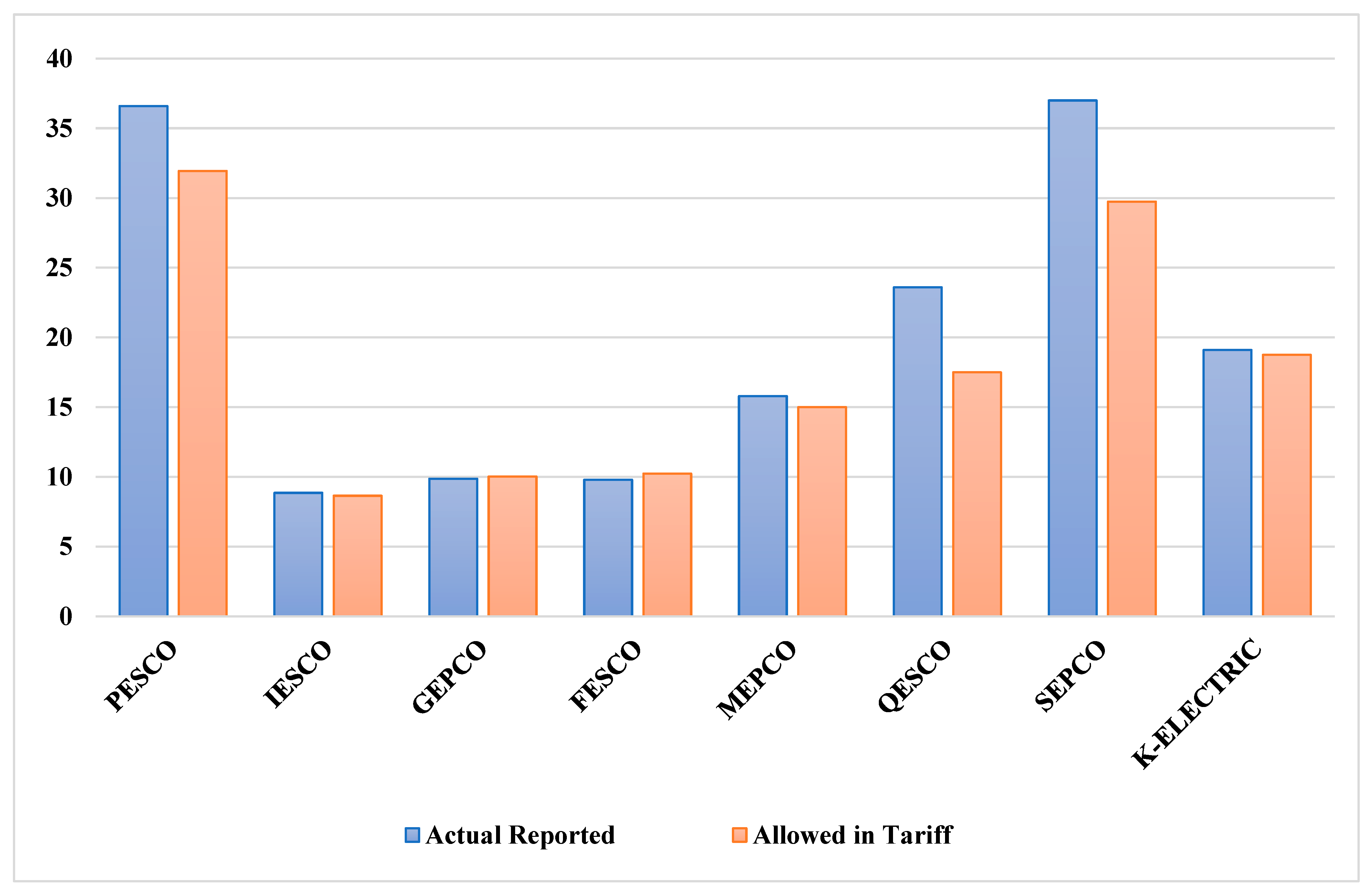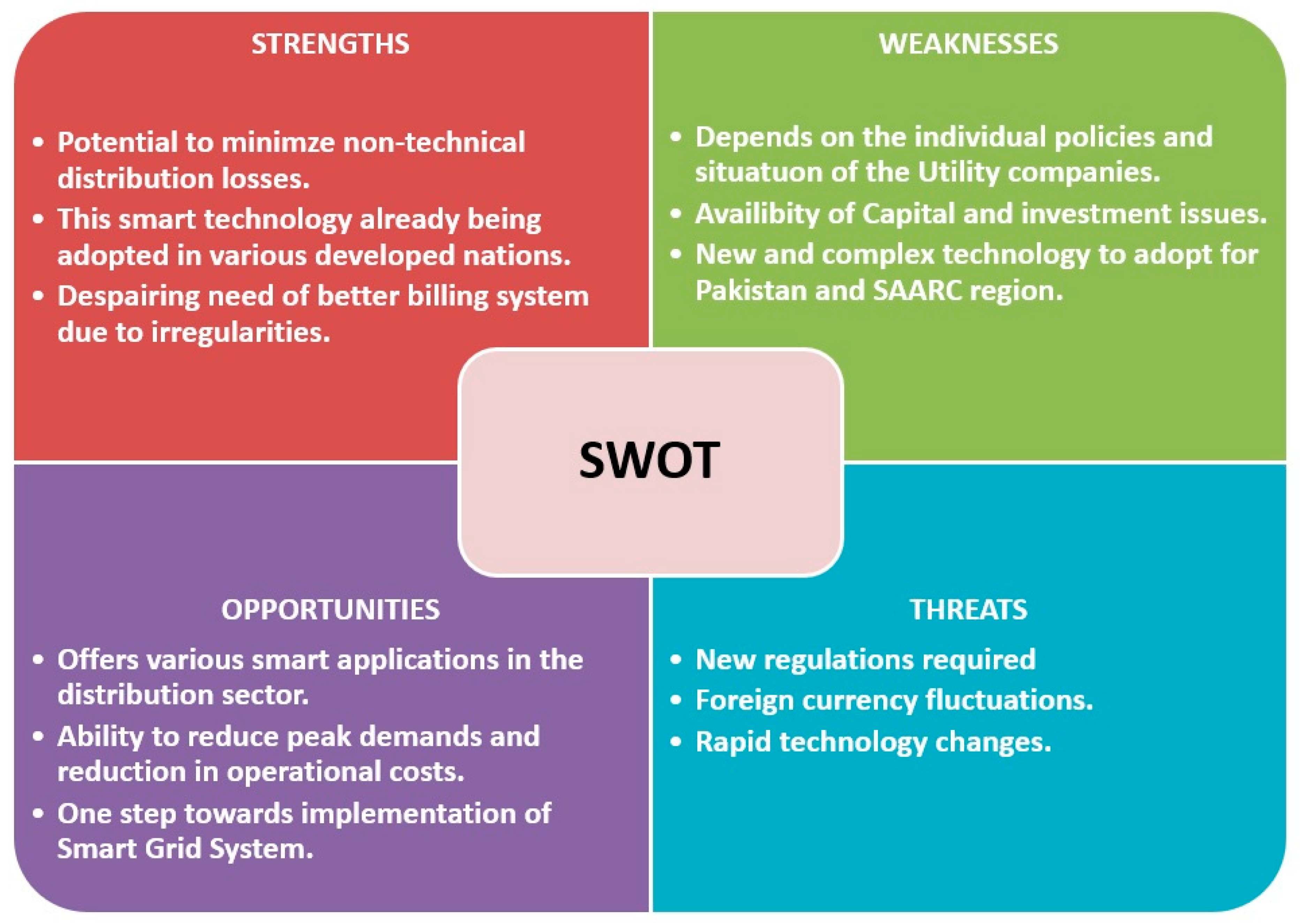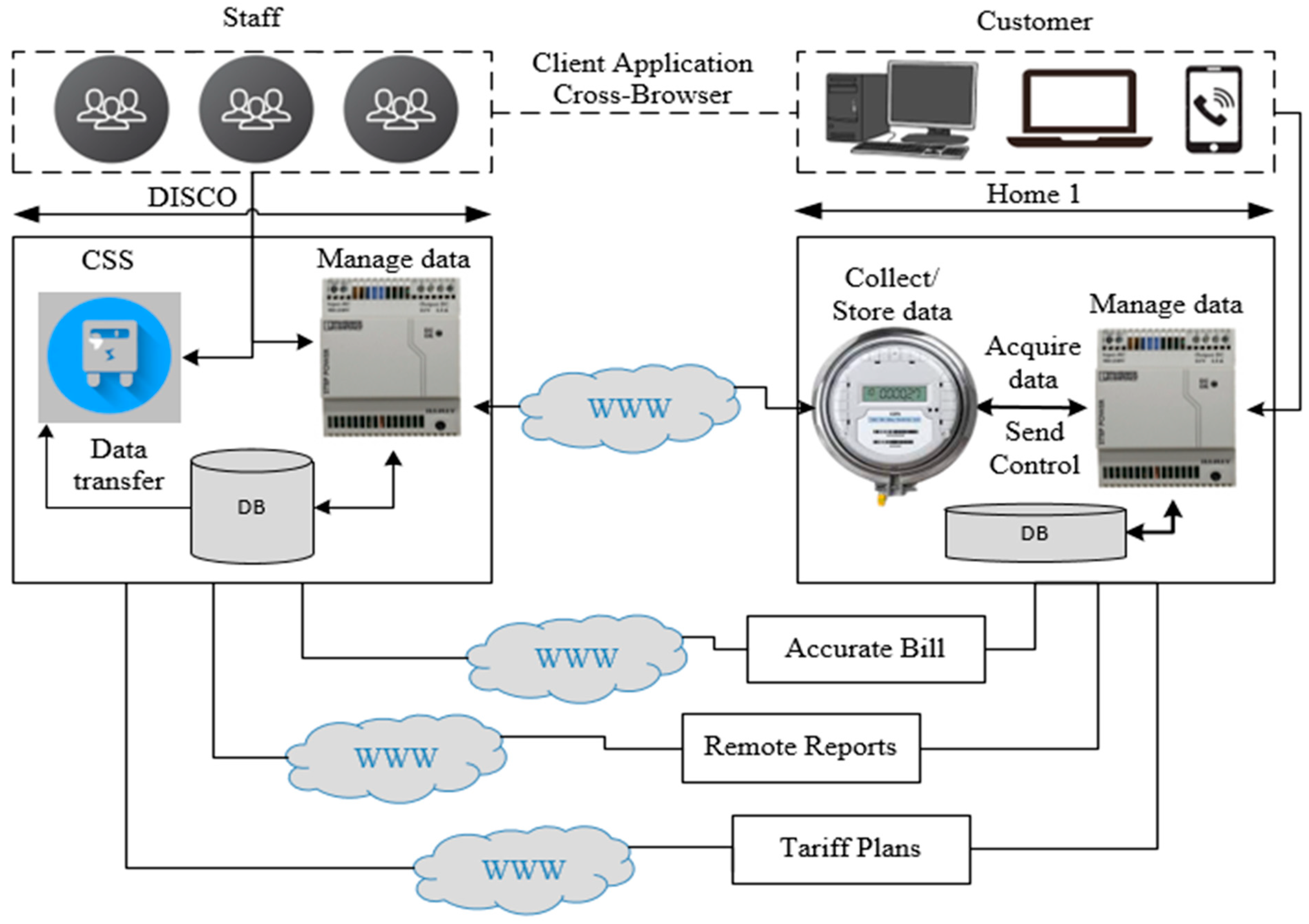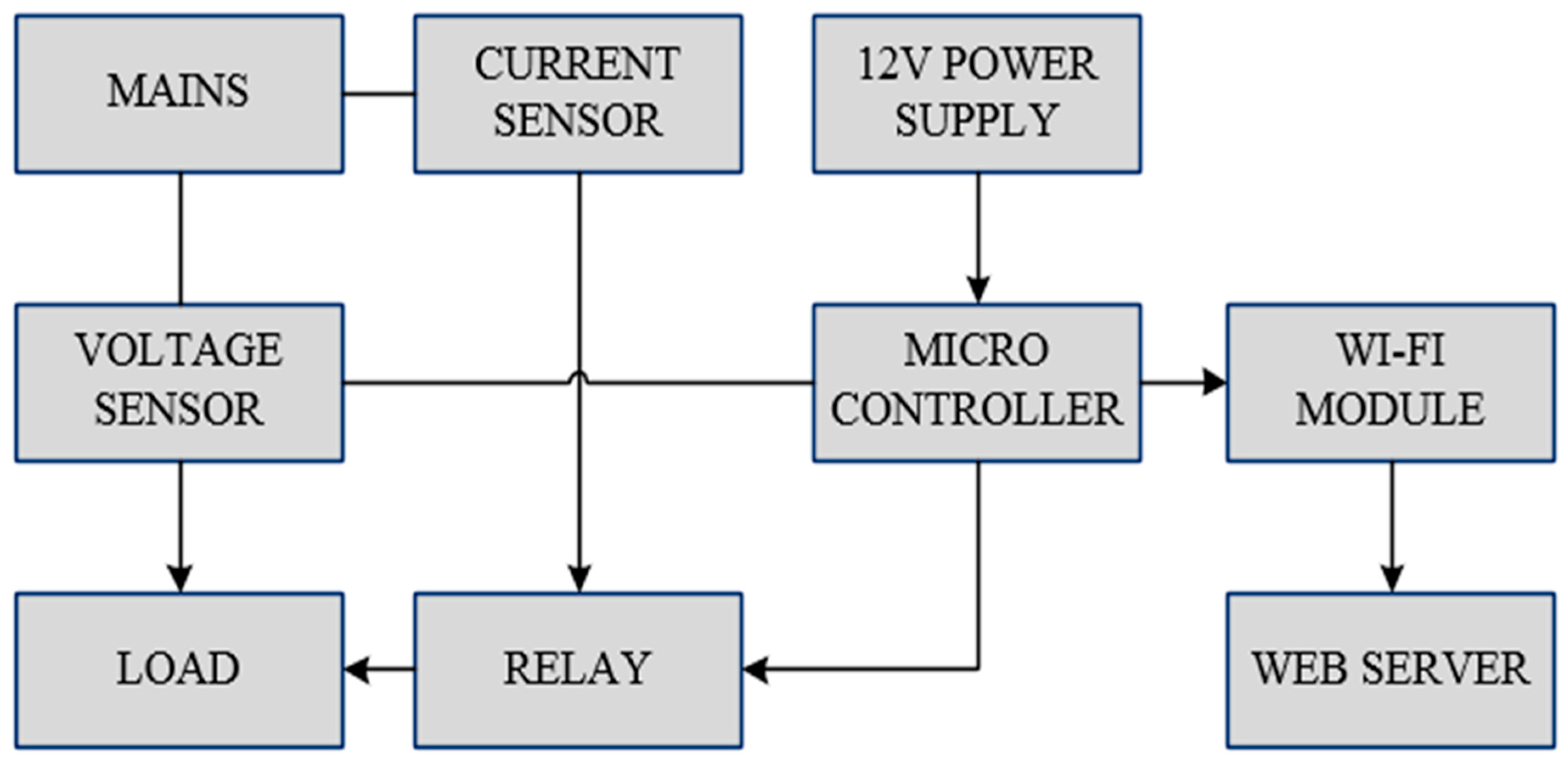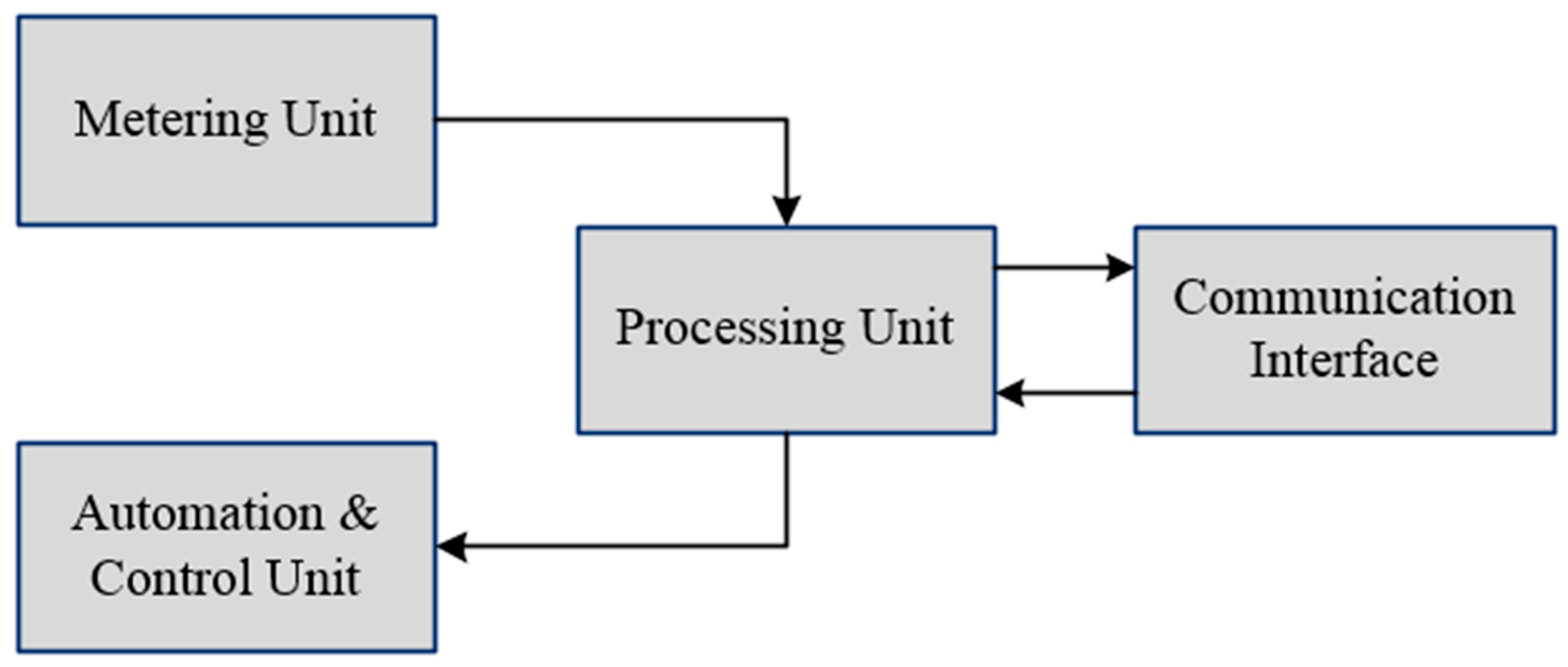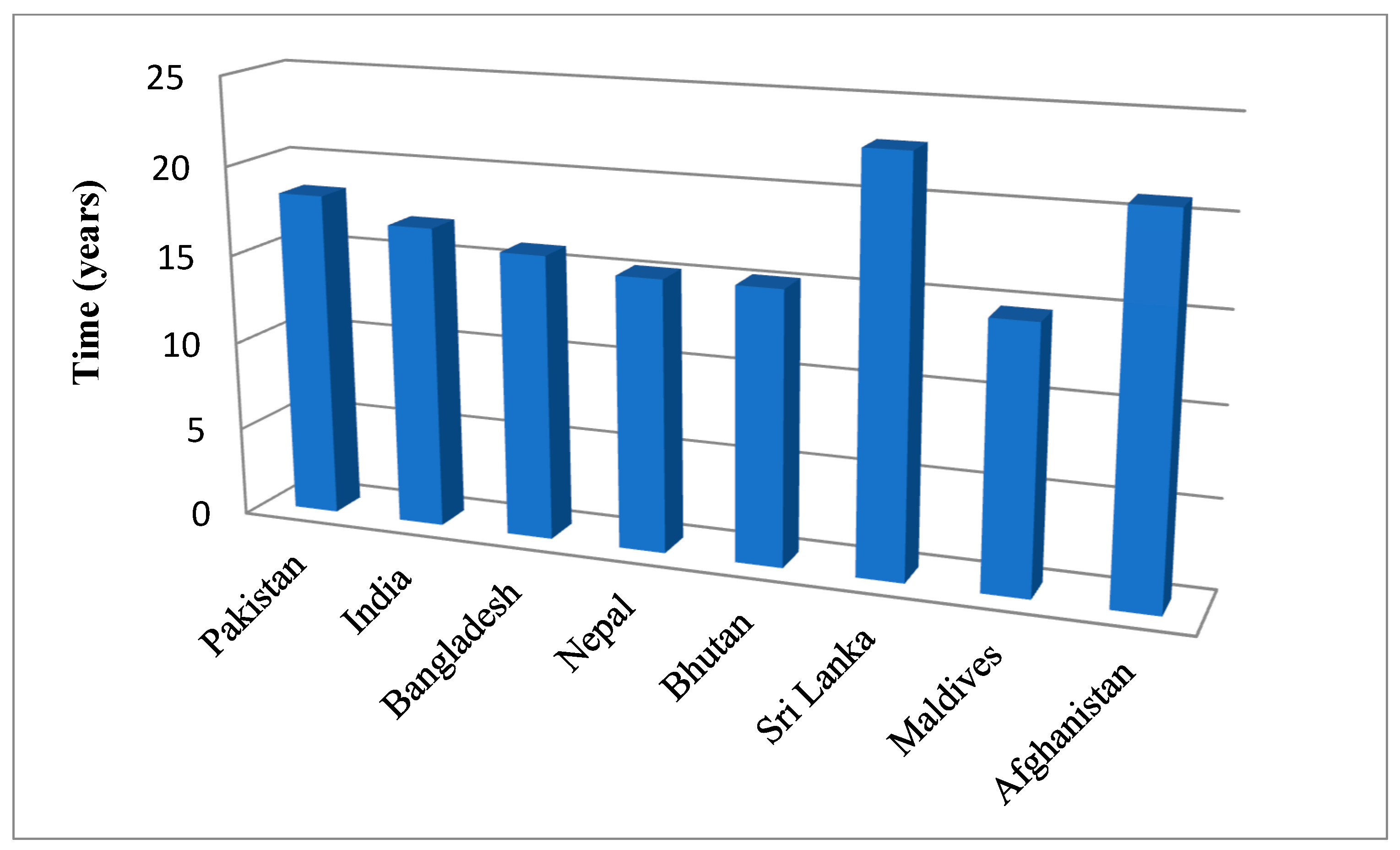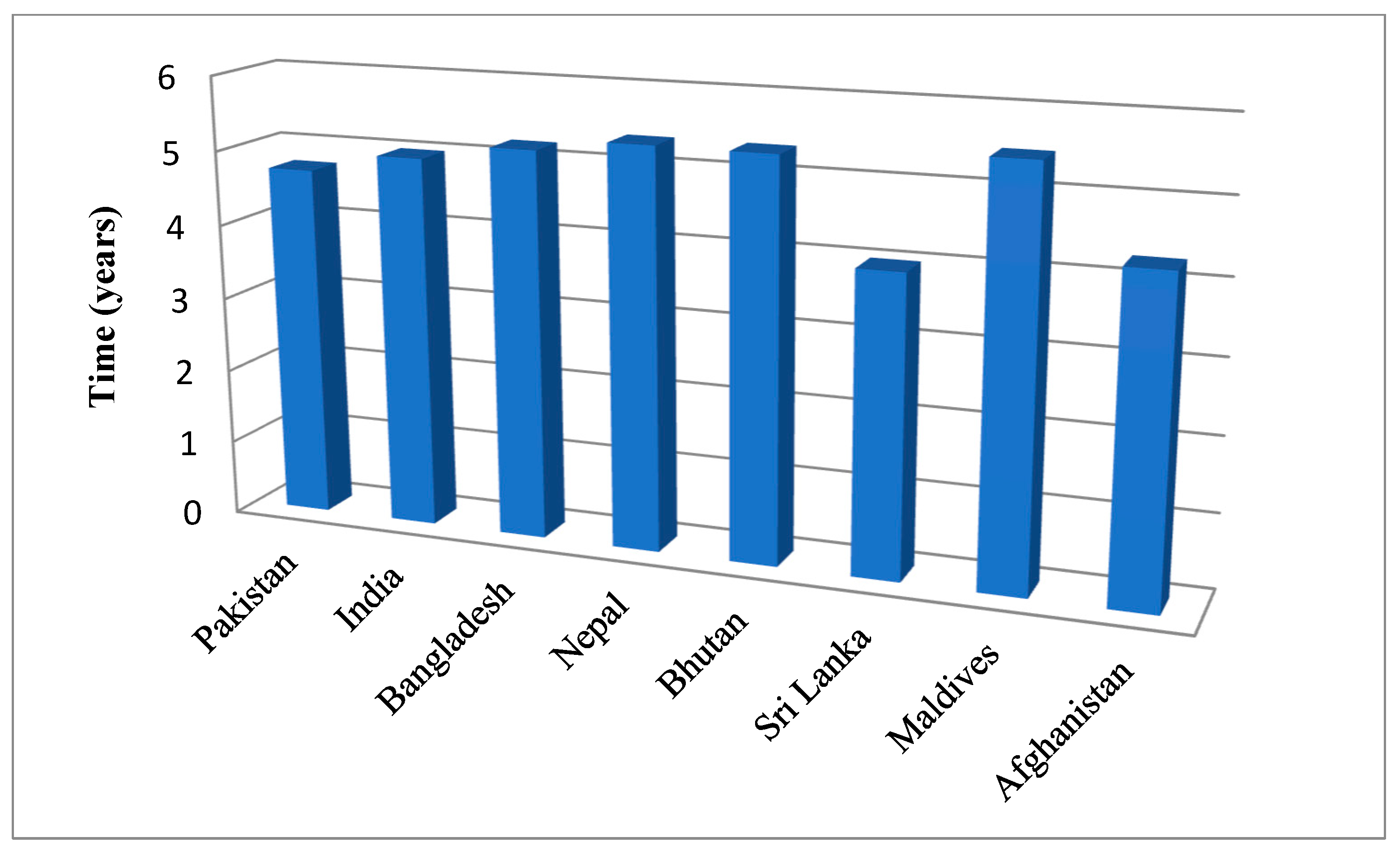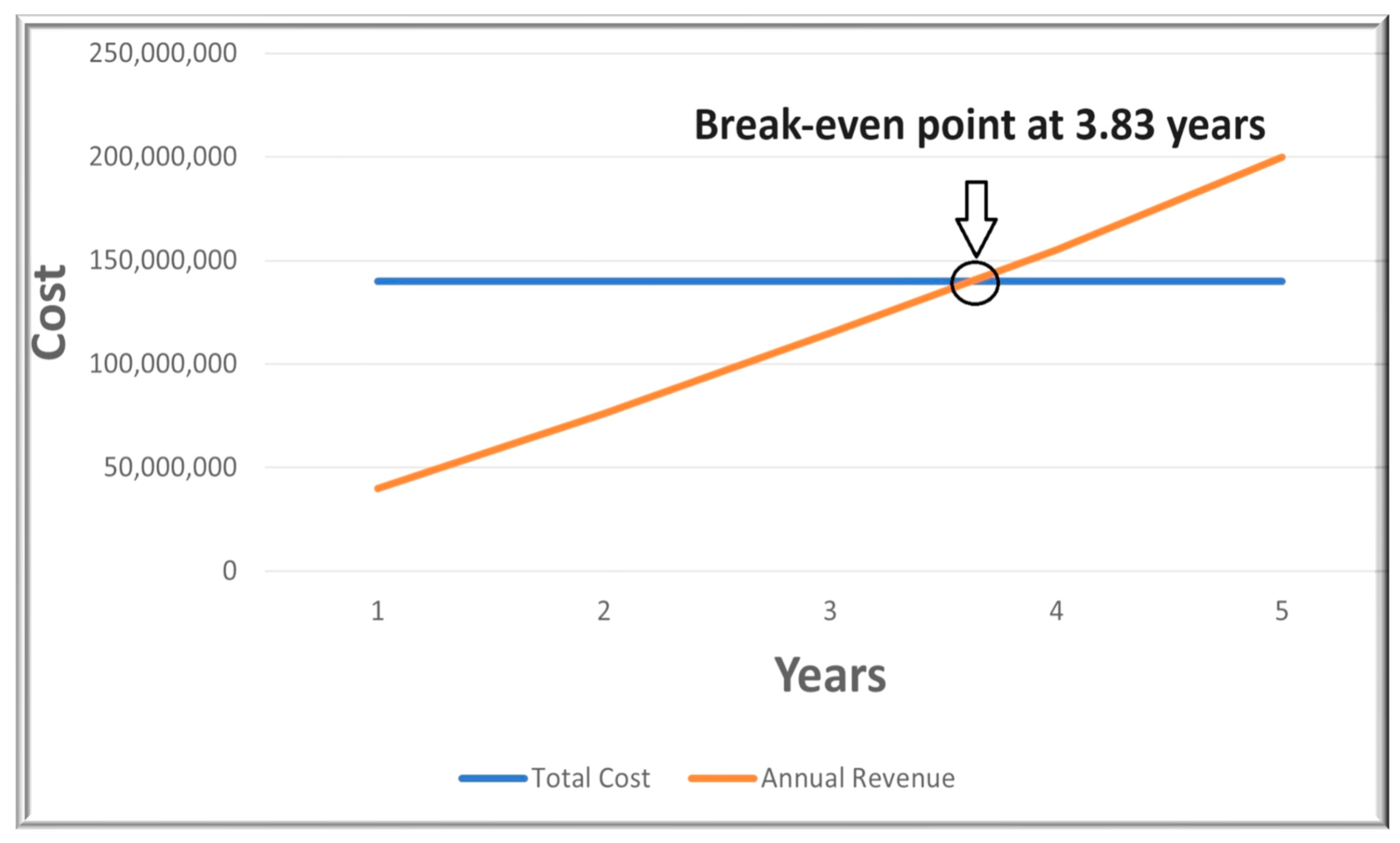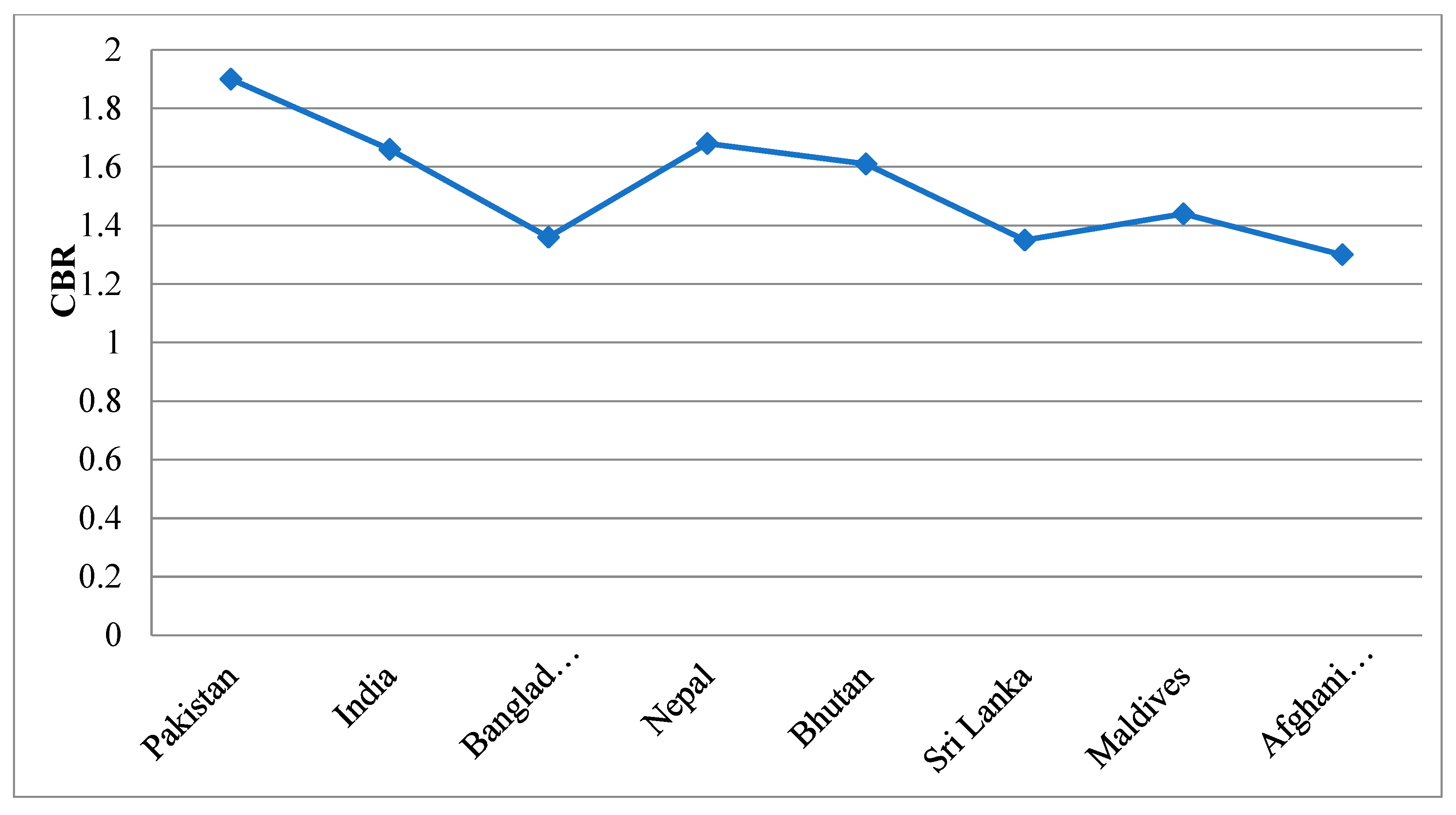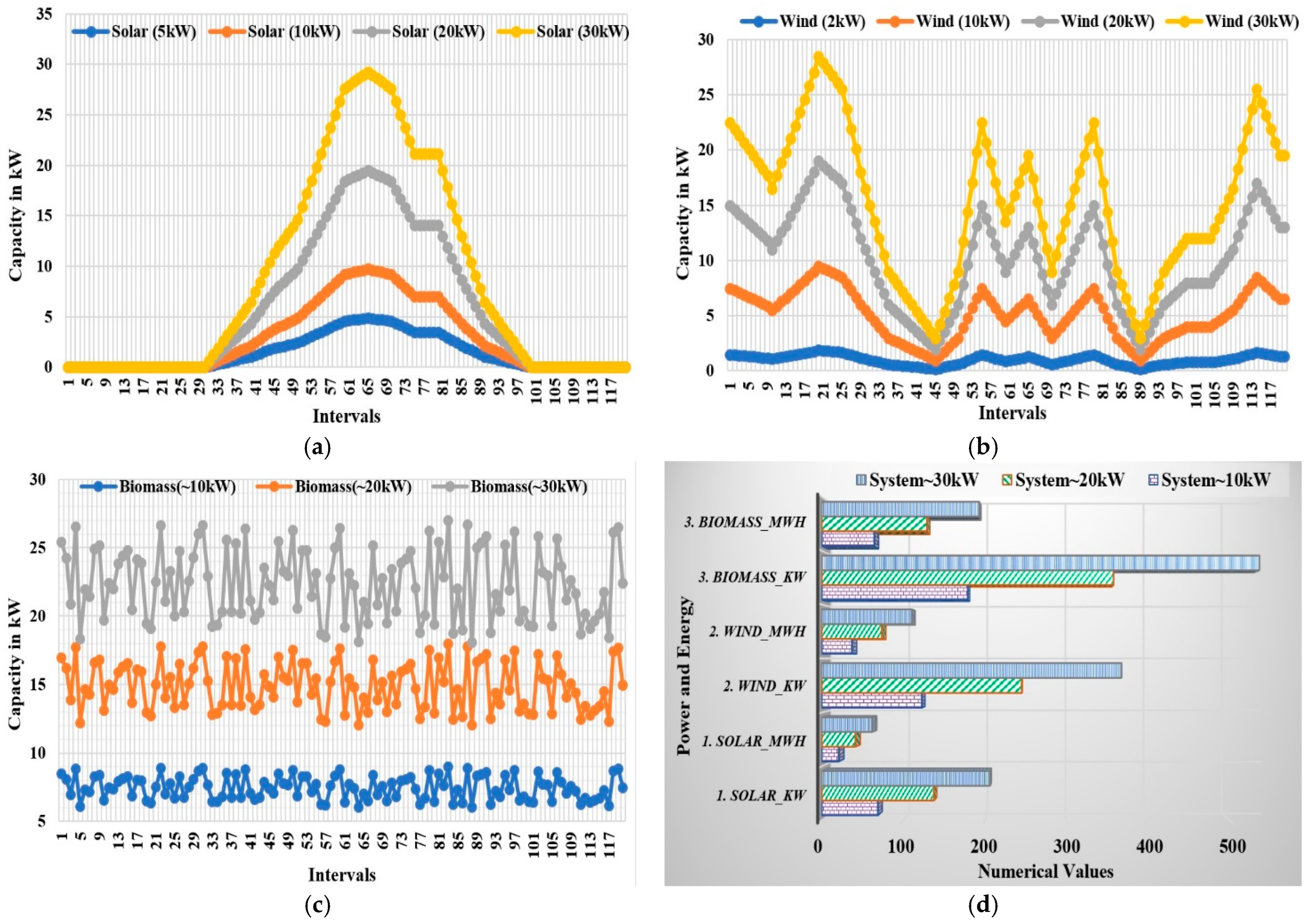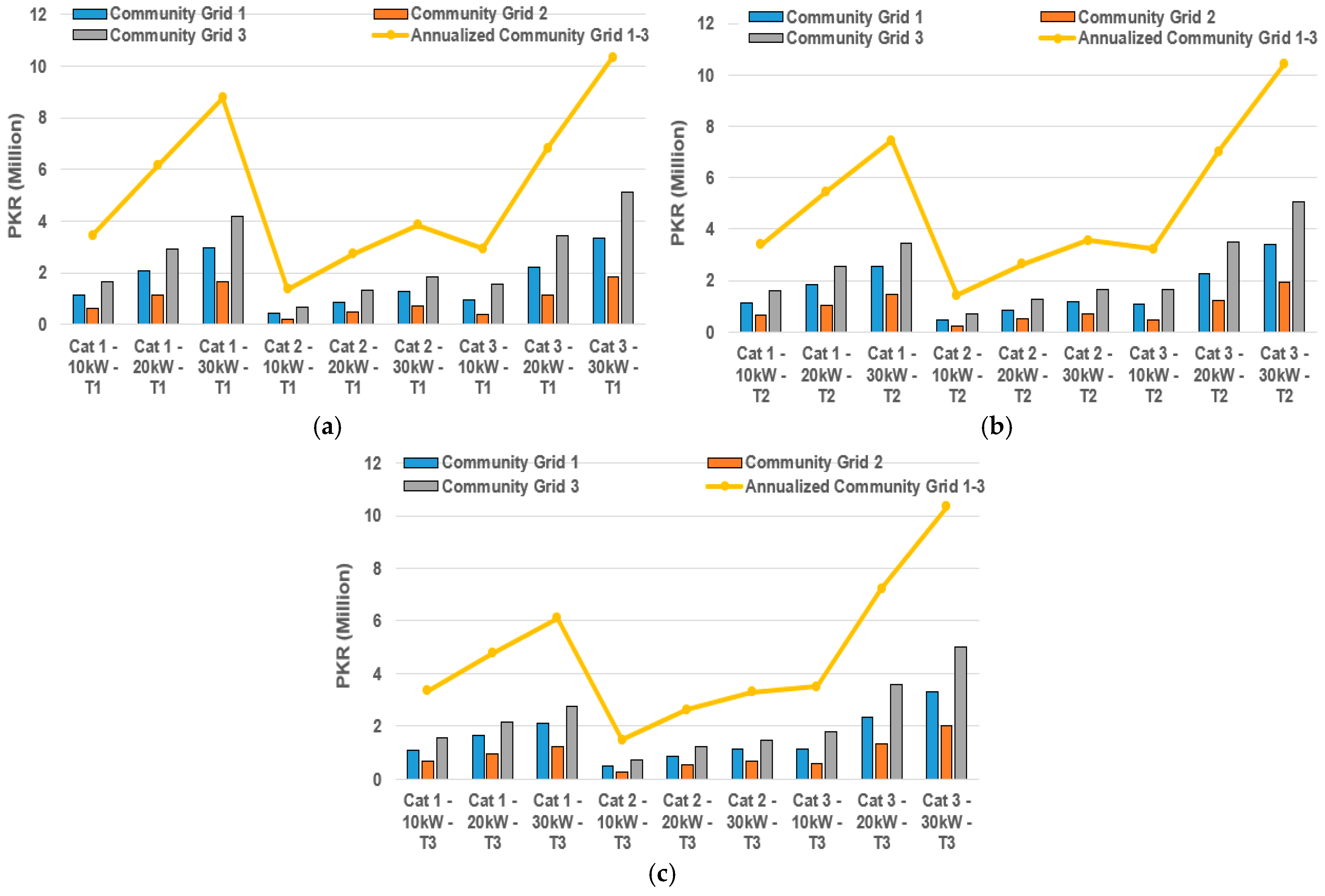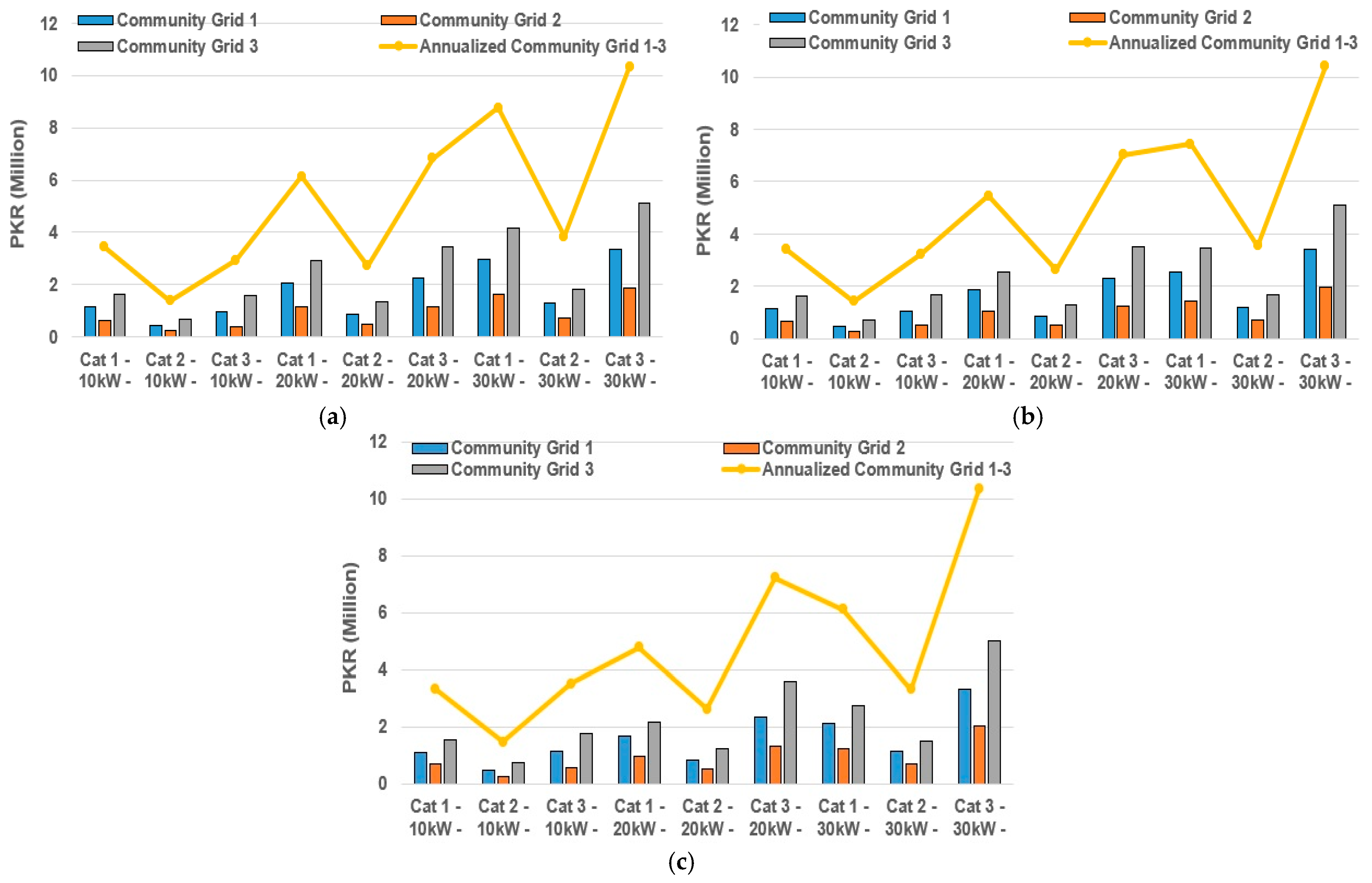4.1. Social Impact of Smart Metering in SAARC Countries
The implementation of smart meters in SAARC countries has multiple benefits. It depends on how electrical distribution companies use this technology. The societal benefits associated with the adoption of smart meters may be interpreted as the primary advantages against the capital investments [
49]. The most important aspect related to the social welfare of society with the implementation of smart metering system is the creation of new job opportunities in the market. Smart metering infrastructure is a complex system having a vast communication network that can initiate different work opportunities for the people. Furthermore, it can introduce the concept of demand response to use the available energy resources in an economical way. The smart system will be able to provide the facility of readily accessible electricity usage data to consumer that leads to better management of their usage patterns. It will result in a reduction of the monthly bills and will encourage the consumers to participate in several demand response schemes offered by the utility companies [
50].
To realize the advantages of smart meters, there is an elementary need that customers should be enthusiastic for the acceptance of this technology. The opposition can be commonly observed in the expansion of other energy development projects, so it can slow down the implementation of the smart metering system. Recent rollout projects of smart meters in SAARC countries suggest that the successful execution of the smart metering system is questionable unless it is appropriately directed to users’ viewpoint [
51].
Conventional norms and ethics often resist new technology. Inadequately addressing society’s concerns about new technology slow its implementation and acceptance. The triumphant deployment of the new technology mainly depends on the widespread acceptance by multiple ranges of people and societies. The acceptance of smart meters by the consumers is commonly diminished by different fears, which are mostly related to the escalated energy bills, violation of the privacy of their usage data, and being unable to control the electricity usage. It is important to change public perception of this new technology and gain public trust for successful implementation [
52].
The electricity usage data of the consumers in Smart metering system can be used unethically to discover residents’ activities. This raises security and privacy concerns among its users. The Netherlands addressed privacy concerns in 2008 during their smart metering roll-out project. Dutch laws set standards for smart meters, ensuring privacy and data protection [
53]. For social acceptance, the country’s legislation introduces flexible consumer functions. Consumers could turn on and off smart meter functions. These issues are crucial for consumer acceptance of smart meters [
54]. The social importance and acceptance can be realized and magnified if the electricity consumers discern the usefulness of smart meters for the environment and society. For example, Sweden’s law subsidizes consumers who use smart meters for hourly electricity tariffs. This example was followed later on by Denmark and Finland [
55,
56].
4.3. Cost–Benefit Analysis of SAARC Countries
A cost–benefit analysis was performed for all SAARC countries and the results are explained in this section. The assumptions for the cost–benefit analysis are shown in
Table A3 in
Appendix A.
Pakistan: In 2021–2022, the total electricity generation capacity in the country was reported as 41,557 MW and the annual consumption was 89,361 GWh [
60]. Only 29,000 smart meters had been installed or replaced with the old ones in different areas [
4]. The government decided to invest PKR 30 billion in the smart meter project for LESCO (Lahore Electric Supply Company) and PKR 17 billion for IESCO (Islamabad Electric Supply Company) [
61]. The estimated price of the smart meter unit is PKR 14,200 in Pakistan. Tax applied on a smart meter is PKR 2414 in 2021 as the tax rate is 17% in Pakistan. The cost of a smart meter is affordable to roughly half of Pakistan’s population. An interest rate is about 15% with the cash flow of PKR 3000, which is the same for 12 years, and the net present value (NPV) is PKR 2055.
India: In 2020, the annual electricity production in India was 1383.5 TWh (1,383,500 GWh) [
62]. A total of 3.73 million smart meters have been placed countrywide as of January 2022, out of a total allocation of 11.16 million smart meters [
63]. India proposed a budget of INR 220 million to convert conventional electricity meters into smart meters by the year 2022. Smart meter prices vary from company to company for all users who use more than 200 kWh of electricity per month. It is reported that approximately 35 million potential clients consume more than 200 kWh per month, and smart meters’ total cost can be assumed as INR 21 billion [
64]. In 2021, India had over 2 million smart meters installed across the country by various entities [
65]. The Indian government budgeted INR 220 billion for the renewable energy and power sectors in the financial year 2020. In India, 18 million smart meters had been developed as of 2019. India will invest USD 25.9 billion in smart meters and grids to modernize its power sector [
66]. The approximated cost of the smart meter unit in India is INR 12,475 with an interest rate of 4.9%. The tax rate is 18% in India which will be INR 2245.5 for a smart meter in 2021. The cash flow for this project is INR 2500 for the next 12 years. Thus, the net present value is 9805 INR. The total number of houses in India is 248.8 million, and the energy sector has the same requirements for smart meters [
67].
Bangladesh: The total electricity generation capacity in Bangladesh is 25,700 MW and the annual electricity consumption in year 2021 was 80,000 GWh [
68]. In 2020 and onward, power distribution companies planned to install 8.8 million smart prepaid meters [
69]. The German government granted BPDB EUR 4.09 million for the cost of a pilot prepaid metering project in Chittagong [
70]. Per day energy generation in Bangladesh is 12,000 MW. A smart meter costs around USD 1050 with a tax rate of about 15% (USD 156) in 2021 and an interest rate of 5% with a cash flow rate of USD 200 for the next 12 years, typically more than conventional meters costing between USD 100 and 500. Thus, the net present value must be USD 732 [
71].
Nepal: In July 2021, Nepal’s annual electricity production was 6052 GWh. and in 2020 it was 6012 GWh [
72]. In Nepal, 1.5 million households have available electricity, and the total system energy needed was 8960.31 GWh [
73,
74]. Nepal carried out six smart meter projects by 2021, deploying 450,000 smart meters by May 2021, 3 million smart meters by May 2023, and a total of 5 million smart meters by May 2025 [
75]. Nepal assigns NPR 62.47 billion to the energy sector [
76]. Electric meter box price ranges from NPR 21,000–24,000. The tax rate is 15%, costing NPR 3218.1 for a smart meter in 2021 in Nepal. The present cost of a smart meter is NPR 21,454 with a cash flow of NPR 4000, an interest rate of 11.06%, and NPV becomes NPR 4433.
Bhutan: In 2020, the total energy production in Bhutan was 7880 GWh, and annual electricity consumption was reported as 2180 GWh [
77]. There are about 163,000 houses in Bhutan. About 96% of houses use electricity for lightning. Bhutan imports smart meters and has a 50% tax rate of RTN 11,250 for a smart meter in 2021. The smart meter price in Bhutan is quite high, which is RTN 22,500, with cash flow being the same as RTN 4200, the interest rate of 12.9% for the next 12 years, and NPV must be RTN 2457. Approximately the same number of meters are needed to be installed in Bhutan to accommodate utility users [
78].
Sri Lanka: Total electricity generating capacity of Sri Lanka is 4086 MW and the annual production is 14,671 GWh [
79]. In Sri Lanka, power is available to the entire population [
80]. The ANTE LECO Metering Company produces 2000 new smart electric meters daily and has already sold nearly 100,000 smart meters in the country [
81]. The union finance minister Nirmala Sitharaman has proposed a budget of LKR 220 million to convert conventional meters into smart meters. The tax on a smart meter is LKR 16 in 2021 as the tax rate is 8% in Sri Lanka. A smart meter price ranges from LKR 10–200, and here LKR 200 is taken. The profit per year is LKR 50 with an interest rate of 19%. Thus, the net present value becomes LKR 30 for the next 12 years of this project. A smart meter is also essential for optimal operation if the end-user incorporates a solar or other renewable energy source.
Maldives: The Maldives consists of 1200 small coral islands and 26 solar hybrid microgrids connected with a shared SCADA system for monitoring and control. A number of 68,249 resident households were counted in the 2014 Census. STELCO’s smart meters record electricity uses for billing and monitoring. The Maldives produces 402 GWh electricity annually, while its annual electricity consumption is 373.9 GWh [
82]. A total of 26 island microgrids in the northern Maldives have 3.2 MWh battery storage, 2.65 MW of solar capacity, and diesel backup. A 100 kW PV system on Fohdoo supplies electricity to one-third of the island, saving 35,000 L of diesel yearly. The tax rate is 6%, which costs MVR 1976.1 for each smart meter in 2021 in the Maldives. Smart meters are imported and have a bit high pricing of MVR 32,935 with a cash flow of 6000 each year, the interest rate of 7% and NPV must be MVR 14,710 in the Maldives. This is a bit higher due to high inflation in the country. Most consumers use solar power; thus, a smart meter can limit energy expenses by sending power to the grid during the day and drawing it at night.
Afghanistan: Total local annual electricity production in Afghanistan is 1000 GWh, while the annual energy demand is 5530 GWh [
83]. Afghanistan’s access to electricity (% of the population) was reported at 97.7% in 2020 [
84]. Total meters are assumed to be 1 million. The average electricity tariff increased from 0.8 to 0.12 per KWh on a yearly basis. From 2013 through 2016, 3 billion dollars was allocated to the power sector [
85]. Smart meter price is USD 150 in Afghanistan with a cash flow of USD 35 per year. Afghanistan imports smart meters and has a 20% tax rate of USD 30 for one smart meter in 2021. The interest rate is 12.14% for cost–benefit analysis, and NPV becomes USD 65.
The cost–benefit analysis of smart meter systems for SAARC countries’ internal rate of return and payback period is exhibited in
Figure 12 and
Figure 13.
A single reference feeder was selected that is operational under the control of an electrical distribution company. Then, non-technical losses associated with the utility’s use of the traditional billing system were analyzed. The capital cost of implementing smart metering infrastructure in that feeder was then calculated. This cost comprises fixed costs and operational and maintenance costs (O&M). The fixed or one-time applied cost includes procuring the required equipment for the implementation phase. However, operational and maintenance costs are variable costs that are estimated for five years. After that, the benefits that can be achieved with the implementation are analyzed in detail. In the end, the cost–benefit ratio and break-even point were calculated.
4.4. Reference Feeder Analysis of Abbottabad, Pakistan
We selected feeder “CANTT. NO.1 PSR”, working under Peshawar Electric Supply Company in Abbottabad, KPK, Pakistan, for reference in this study. This feeder is connected to the “132 KV Grid station” on Murree Road, Abbottabad, Pakistan. The total number of feeders connected with the grid is 14. The number of domestic consumers being fed with feeder “CANTT. NO.1 PSR” is 7500. The electricity usage data of the reference feeder for one year is given in
Table 2.
The total kWh supplied to the consumers of the reference feeder was 17,769,000 for the year 2020/21, while the feeder faced 16% of non-technical losses and was only paid for 14,925,960 kWh. We will estimate the total cost of implementing the smart metering system for this feeder. The cost of the smart meters required for the consumers fed by the selected feeder is explained in
Table 3.
This is the part of fixed cost. The estimated cost for installing smart meters at consumers’ premises is PKR 60,000,000 [
86]. We considered the “RF Mesh network” in the neighborhood network as a communication medium. While collecting complex data coming from the consumer’s side, a data concentrator unit (DCU) should be installed. For optimal results, at least one data concentrator unit is required per 100 energy meters [
87]. There are 7500 consumers attached to the feeder, so we will need to install 75 data concentrator units for the selected feeder. The detailed estimated cost for the installation of the “Neighborhood Area Network” is explained in
Table 3, which also comes under the fixed cost category [
86,
88].
The estimated cost for installing the Neighborhood Area Network was PKR 8,250,000. The overall smart system installed at the utility end consists of a Head End System (HES), a meter data management system (MDMS), a computer hardware and networking system, and System Integration. The respective costs are given in
Table 3, which are also fixed costs. The cost given in
Table 4 is the overall cost of installing a smart metering infrastructure in a grid station. We are considering only one feeder, so the total number of feeders connected with the 132 kV grid station is “14”. Consequently, this cost is divided by 14 to get the average cost for one feeder [
86,
88]. The estimated cost for one feeder is PKR 17,142,857. If we sum up all the mentioned fixed costs, the total fixed cost becomes PKR 85,392,857 (=60,000,000 + 8,250,000 + 17,142,857).
The Operational and Maintenance cost (O&M) is variable. We used five years to estimate the variable cost. The first cost under the O&M category is the “annual maintenance of installed smart meters” at the consumer’s end. We set the cost with the ratio of 2.5% of the total cost of the installed smart meters per annum. “Data concentrator unit” (DCU) maintenance will fall under the second category. The overall annual cost of the data concentrator unit is computed as 2.5% of the cost of the unit itself. The third category was “Annual maintenance of Head End System”. This cost was calculated with a ratio of 20% of the total cost of the Head End System per annum. The fourth category was entitled “Meter Data Management System Annual Maintenance.” The entire cost of the meter data management system is determined by the ratio of 20% of the total cost. Computer hardware and networking systems are put into yearly maintenance in the fifth category; 10% of the total cost of the computer hardware and networking system was used to estimate this cost [
86,
88]. All these costs are given in
Table 4.
To calculate the overall costs for the implementation project, we add up the fixed and variable costs, and the total cost becomes PKR 101,866,000 (=Total fixed cost + Total variable cost = 85,392,857 + 16,473,214). An interest rate of 7% to the overall cost for 5 years accumulates to the total cost of PKR 137,519 million.
Now, the benefits associated with the project’s implementation will be estimated. The first benefit will be the cost savings associated with the meter reading. Around PKR 30 per month can be saved for each user because the meter reader will no longer be required to record energy consumption data manually, and this data will be free of human error.
Table 5 summarizes the expected savings in this category:
The second advantage is the cost reduction associated with manual data entry and bill calculation. With a smart metering system, approximately PKR 15 per month can be saved per consumer compared to manual data entry and bill computation. The estimated savings for this category are provided in
Table 5. The primary benefit of implementing a smart metering system will be the reduction of non-technical losses (electricity theft). From
Table 2, we can see that the total units supplied by the feeder for the period February 2020 to March 2021 were 17,769,000 kWh. At the same time, the return units for which PESCO was paid were 14,925,960 kWh. Thus, the utility faced a loss of around 16% for the reference feeder. With the implementation of a smart metering system, this loss can be reduced to 6%. The utility will benefit from saving the cost of reducing electricity theft by up to 10% [
86,
88]. The benefit of reducing non-technical losses was calculated in
Table 6 based on a rate of 1 kWh at PKR 18.
Summing up all the benefits are shown below:
Annual benefits = 2,700,000 + 1,350,000 + 31,804,200
Annual benefits = PKR 35.854 million.
If we analyze the total benefits against the applied cost, we get a ratio of:
Pay-back period = Total Cost/Total Benefits = 137,519,120/35,854,200
Pay-back period = 3.835 years
The break-even point is explained in
Figure 14.
The calculated break-event point for the proposed project is 3.835 years. This project can recoup its capital costs within this time frame. The revenue generated cuts the cost graph at the value of “3.835” years, indicating that the proposed project was capable of covering its applicable costs during this time and will move to the profit portion after this period. The proposed project’s application cost can be covered by operational gains such as reduced electricity theft, bill computation, meter reading savings, increased consumer services, and faster outage detections. Only electricity theft and meter reading savings were considered here for the calculations.
4.5. Cost to Benefit Ratio of SAARC Countries
In cost–benefit analysis, the benefit-cost ratio (BCR or cost–benefit ratio = benefits/costs) measures an asset or project’s ability to generate cash flows. The BCR is the ratio of the project’s benefits to the present values of a project’s costs. If BCR > 1, the asset or project will yield a higher value. HXE12 static single-phase RF enabled energy meters to assess electric energy for single-phase two-wire residential and commercial users. The meters meet with IEC 62053-21 and 62052-11 [
89,
90] and WAPDA standards for accuracy class 1. These meters employ low-energy radio waves to send data.
The Three-Phase Electronic Electricity Meter HXE 34 measures active and reactive energy, maximum demand, and multi-tariffs for industrial clients in three-phase networks. The meter meets IEC 62053-21, IEC 62052-11, and WAPDA Standards [
91]. The measurement system uses a high-quality measuring IC. Measuring elements are shielded from external magnetic fields up to 0.5 Tesla, over-voltages, and high-frequency disturbances [
92]. This type of metering element ensures outstanding metering features, high metering reliability, little effect of influence quantities, and no re-calibration over the meter’s lifetime.
The seven-segment LCD displays eight-digit measurements (all integers or multiple decimals). Each parameter/quantity has an LCD ID. The symbol representing energy flow direction, tariff flags, and meter status are also shown. The meters register energy at different rates with hour-by-hour and minute-by-minute resolutions. Seasons and holidays can be configured for up to four tariffs. Smart meter costs differ in all countries, and the benefits and cost–benefit ratios are shown in
Table 7.
Pakistan has set aside a sizable budget for the installation of smart meters, costing PKR 14,200 per meter and offering the highest cost–benefit ratio among SAARC nations at 1.9. Afghanistan invests a very low budget in the energy sector and smart meters, with a minimum cost–benefit ratio is 1.30 for smart meters. The cost–benefit ratio is illustrated in
Figure 15 of smart meters in SAARC countries.
4.7. Future Perspectives of Smart Metering
In connection with the transition to smart grid technology, smart meters have intelligent capabilities and can play a versatile role in meeting consumer demands. Smart meter can measure and communicate comprehensive instantaneous electricity consumption and offer better control of electricity usage, facilitating real-time monitoring and offering real-time pricing at the consumer’s end. They analyze the electricity usage data transmitted back to the grid, so the utility companies should be aware of the electricity usage pattern of the respective consumers [
98].
This smart technology appears to be the most significant innovation in the energy distribution sector in recent years and is indispensable for all market participants. A smart metering system can:
Offer a solution to the utility companies seeking a reduction in meter reading costs;
Provide the way-out to operators looking to modernize the grid station;
Propose the best solution for governments to achieve energy saving and efficiency goals.
Smart meters offer a variety of functionalities that utilities may adopt in the future to enhance their functionality and provide additional services to their customers. Demand-side management is one of the most vital applications that utilities may adopt with smart metering system rollout. Demand-side management is a terminology that is frequently used to refer to the programs that utilities can implement to manage the energy usage pattern of their consumers. Several energy-saving schemes can be introduced to maximize the efficiency of available energy resources without demanding new generation facilities and transmission frameworks [
99]. The major examples of demand-side management programs include demand response schemes, energy conservation plans offered by utilities, fuel trade-off plans, and residential and commercial load monitoring and management schemes. Residential load management programs typically focus on lowering energy usage, encouraging consumers to adopt more energy-efficient consumption patterns, and building energy-efficient structures [
98,
100].
Currently, most developing countries have no concept of adapting DSM techniques. Due to the unavailability of any direct communication platform with their customers, utility companies cannot offer any DSM application to their consumers. Implementing a smart metering system will enable utility companies to offer various functionalities like “Time of Use” tariffs and DSM technologies to maximize the efficiency of available energy resources [
98]. Another important application offered using smart meters is the “home energy management system” (HEMS). It is a mesh network that aids in managing a household’s electrical power supply to reduce energy consumption. A smart metering system enables the communication between the utility and home network services by implementing automated meter management and automatic meter reading via smart energy meters. A smart meter is considered a critical element in building an advanced metering infrastructure that monitors the energy usage of several home appliances [
101]. Smart meters can transmit energy usage data from consumers to utility companies. This data can be used to make electricity generation and distribution decisions and prepares consumer bills. The utility companies will be able to transmit cumulative energy usage data, associated pricing, and power control commands to the smart meters installed at the consumer’s end. This enables displaying the information on an in-home display that will encourage the customers to reduce their energy consumptions specially during the peak load [
102].
